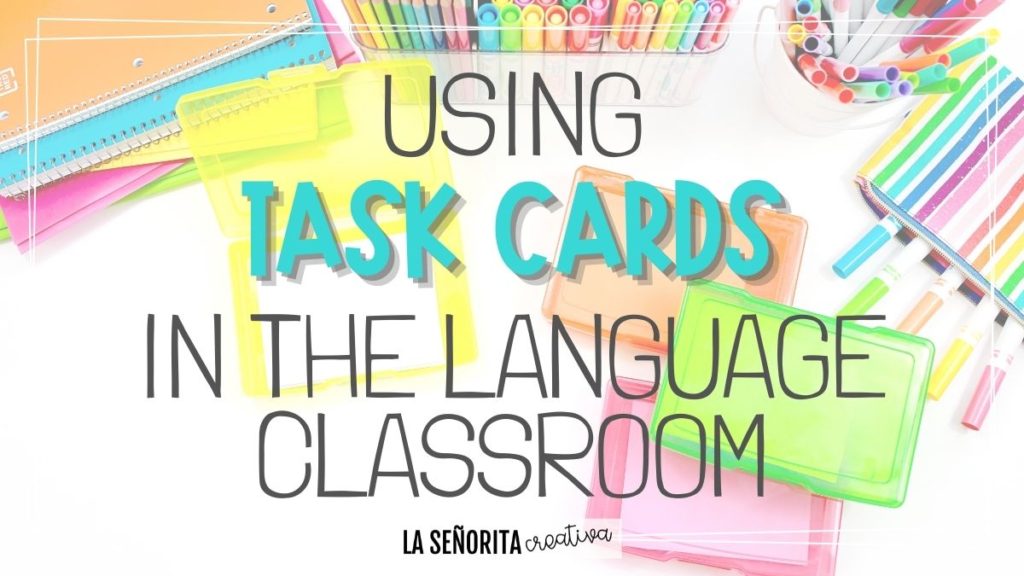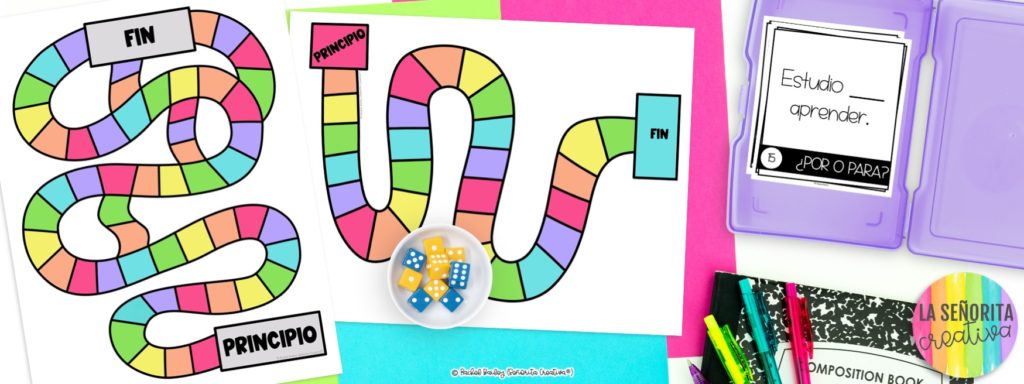
It seems like task cards are everywhere these days, and for good reason! They are such a versatile tool and can be used in so many different ways in your classroom. Keep reading for my eight favorite ways to use task cards in my language classroom.
1. Gallery Walks
Gallery Walks are one of my go-to activities because they are perfect for just about any concept you want your students to practice and they are so easy to set up! All you need is a way to stick the task cards to your walls (tape, push pins, sticky tack, etc). Before class, go around the room and affix your task cards all throughout your classroom (or down the hall, depending on your school culture and what is allowed on your campus). You can put the cards up in order or scramble them up. Give your students a recording sheet to write their answers on (clipboards make this so much easier for your students!), set a timer, and go!
2. Scavenger Hunt
Scavenger hunts take gallery walks to the next level – students still circulate around the room or designated space, but now the cards are hidden and they have to find them. This adds a little fun and challenge to the activity. Just like with gallery walks, I give my students a recording sheet and set a timer.
3. Whiteboards
This is possibly the easiest, lowest-prep way of using task cards. Simply project your screen with the PDF or PowerPoint/Google Slides, give your students dry erase boards (cardstock in page protectors also works well!) and markers, and you’re ready to go. There are two main ways I use this activity with task cards. The first is simply to have the students write their answer on their board and hold it up for me to check. Sometimes I have them show me as soon as they have their answer and sometimes I have them wait and they all hold their boards up at once.
The second way I like to do this is a modified think-pair-share activity. First, I pair my students up (check out my post here for three easy ways to partner your students up). I will show the question and give the students an appropriate amount of time to think and write their answer on their board. Then, with their partners, they share and defend their answers if they differ. They must agree on one correct answer to share out. Finally, I will choose a group to share their answer and their reasoning. If it’s a question with multiple correct answers I usually call on three or four groups to get a good variety of responses.
4. Scoot
Scoot is a tried-and-true classic activity and a great way to use task cards to get students out of their seats. Place on card on each desk and get your timer ready. Again, I prefer using timer videos that I project on the board so that students can see how much time they have left. Depending on the complexity of the card and what it asks the student to do, I give anywhere from 30 seconds to 2 minutes for each card. Once the timer goes off, they have to “scoot” to the next desk and complete that card. My students don’t tend to enjoy scoot as much as gallery walks or scavenger hunts, because they feel like there’s too much pressure since they can’t go at their own pace, but this is a great option for some groups!
5. Board Game
Using task cards with a game is tied with gallery walks for my favorite way to use them in my Spanish class. It’s easy to set up, depending on the game they are playing. I’ve used this with Candy Land-style games, checkers, Sorry, even Jenga! The premise is simple – in order to move (or make their next play), the student must draw a task card and answer it correctly. If they do, then they get their turn and they play as usual. If not, their turn is over. You can do this with printable game boards and playing pieces or you can buy board game sets cheaply from places like the dollar store or thrift stores. Grab my freebie below for some easy printable game boards, along with three ways I’ve used them in my classroom.

6. Inside/Outside Circles or Speed Dating
Another classic technique that can be used for so many topics and tasks is inside/outside circles. This strategy is very similar to the speed dating strategy. For this activity, split your class into two groups of equal sizes. If I have an odd number of students, I will either participate myself or have a group of three (depending on the class make-up and how much active management they need). The two groups will sit or stand facing each other, with each student facing another student (so that every student has a partner). They each need a task card of their own for this activity. They will ask each other the question on the card (or discuss the sentence, why the answer is right/wrong, etc) for a specified amount of time (30 seconds to 2 minutes usually, depending on the complexity of the card). Once time is up, one group (usually the outside circle) will rotate so they have a new partner. Every 4-5 rotations or so, I have them switch cards so that they don’t keep the same card the whole time. Check out this youtube video for a better explanation of the strategy and to see it in action in a French classroom.
7. Entrance or Exit Ticket
I love having an entrance ticket for my classroom. It’s a great way to get a little face-time with every student, take attendance, and get a quick formative check in all at once. My district’s policy is that teachers be in the hallways during passing periods to help monitor and cut down on disciplinary issues, and this practice stemmed from that policy.
Some days I would just have a question related to the unit they had to answer in the target language. At the beginning of the unit I would typically have a simpler question such as a yes/no or this/that question (such as “Do you prefer corn tortillas or flour tortillas?” or “Do you go to bed before or after 10 PM?”) and they get more complex as the unit progresses (“What is your favorite food? Why?”, “What do you need for math class?”, or “What were you like when you were younger?”). Other days, I would pull out a stack of task cards (related to the current unit or a review of a past unit) and have the student pick one at random and answer the question on the card or complete the task. I keep a running record in my gradebook, both for attendance and as a weekly formative grade. This also gives me good insight into what I need to make sure to review or where my students need more input or practice. Above all though, it is a great way to build relationships with my students, and ensure that I speak with and check in on every kid every day.
8. Time Filler
The last way I use task cards is as a time filler. No matter how well planned the lesson, sometimes we finish early. Instead of wasting those minutes, I will pull out a stack of task cards. Sometimes I use a document camera to project the cards for the whole class to read, other times I read out the question for them. Occasionally I will pass the cards out to the students and have them complete a few in their notebooks. No matter how we use them, this is a great, productive way to use up a few extra minutes.
I’d love to hear your favorite way to use task cards, tell me in the comments!





 Raise your hand if you're looking to add some
Raise your hand if you're looking to add some 



 awesome
awesome 


